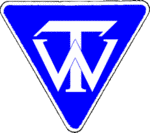Tesla-Westinghouse
| Tesla-Westinghouse | |
|---|---|

| |
| Type | Private Company |
| Slogan | We light up the world We light up the world |
| Founded | 1886 as Tesla Electric Light & Manufacturing |
| Location | New Amsterdam, NAL and Raguza, Dalmatia |
| Key people | Sohen So, CEO & Director |
| Employees | 15,400 |
| Industry | Electric and Engineering Company / Congolomerates |
| Products | aircraft jet engines electricity |
| Revenue | |
Tesla-Westinghouse is currently one of the largest conglomerate companies in the world, with significant bases of operation in over 70 countries around the world. The primary corporate centers are found in New Amsterdam, Castreleon New, NAL and Raguza, Dalmatia.
Tesla-Westinghouse is largely focused on the electric and electronic industries, however it does maintain interest in other industries as well, including finance, and motors.
Foundation
Founded in 1886 as a cooperative venture between Nikola Tesla and Charles Batchelor, Tesla Electric Light and Manufacturing was heavily involved in the War of Currents against Thomas Alva Edison's General Electric Company.
This was a particularly bitter confrontation as both Tesla and Batchelor were former employees of Edison. Tesla and Batchelor had left their employment with Edison following a disagreement. Edison had reputedly promised Tesla a £5,000 should he be able to improve the designs of ?electrical transmission devices. When Tesla had done so, and asked Edison to make good on his promise, Edison reneged, saying that he couldn't pay Tesla all £5,000 at once. He offered Tesla a raise and the rights and revenue to several of the patents to repay over time, until he could come up with the total sum. When he failed to do so, Tesla left Edison, and Batchelor followed, incensed that Edison would make such a promise and then renege.
Within a few months they had established Tesla Electric Light and Manufacturing, cooperating with George Westinghouse in the War of Currents. Following Westinghouse and Tesla's win for alternating current, they began a groundwork for cooperation between their two companies. While Tesla was in Louisianne researching, Batchelor completed the transaction and federated Tesla-Westinghouse.
Early Years
For the first 20 years from its creation, Charles Batchelor served as the CEO of Tesla-Westinghouse. While Tesla was offered the position of CEO he refused, saying that he would take a small stipend from the company and funding to support his endeavors at Wardenclyffe.
In 1905 Tesla-Westinghouse purchased the ailing General Electric Company for £300,000 and integrated their holdings. All customers who had been using direct current electricity in New Amsterdam were switched over to alternating current by 1920.
With their grasp of electrical patents, Tesla-Westinghouse was integral in protecting the tramways of Louisianne as it intervened to protect its interests during the Affaire des Tramways. Many historians in recent years have cited the effects of Tesla-Westinghouse on the legal proceedings, noting that without the political and economic clout of Tesla-Westinghouse, it is highly likely that the tramways of Louisianne, and possibly other nations in North America would have been eliminated.
Using Tesla's patents for electric turbines, Batchelor urged development of electrical engines, and was quickly supported by the members of the board. This research proved to be a critical component in Tesla-Westinghouse's success, as by 2005 nearly one-third of all electric locomotives the world were of TW design.
Innovations
It was the Raguza division of TW that worked on and developed Tesla Generators. In cooperation with the government of Dalmatia, TW agreed to give the Dalmatian government full control of the whole design but retained the right to improve on parts of the design which they can then license. The CSDS government was initially very reticent to allow this, but acceded to TW's request when promised that no innovations would be put on the market until Generators were built outside of Dalmatia. Oddly enough, this happened a mere 10 years later.
Growth
Tesla-Westinghouse has continued its growth, expanding from electricity and motors to medical imaging systems, expanding upon the groundwork of Tesla, and more importantly, Marie Curie. Today, TW is one of the world's largest companies, providing innovation in many areas. TW engines have been used in the world's best aircraft, including the Stratoliner recently developed by Wenedyk Hindenburg S.A.. L'Aigle, the private presidential aircraft of Louisianne's First President is fitted with TW engines, for which the specifics are not disclosed. It is believed that they are more powerful than those used on the Stratoliner.
TW has also been instrumental in the growth of rapid-rail lines the world over with their engines being able to function with or without the use of Catenaries, making it possible for the high-speed rails to work across international borders where voltages and regulation might not be consistent, due to the use of the Tesla Generator Engine.
In 2011, TW unveiled their first test train of a new type, magnetic-levitation, running a test circuit in Dalmatia. Following successful testing TW expects to market these new trains to existing and new customers around the world.
Car Industries

|